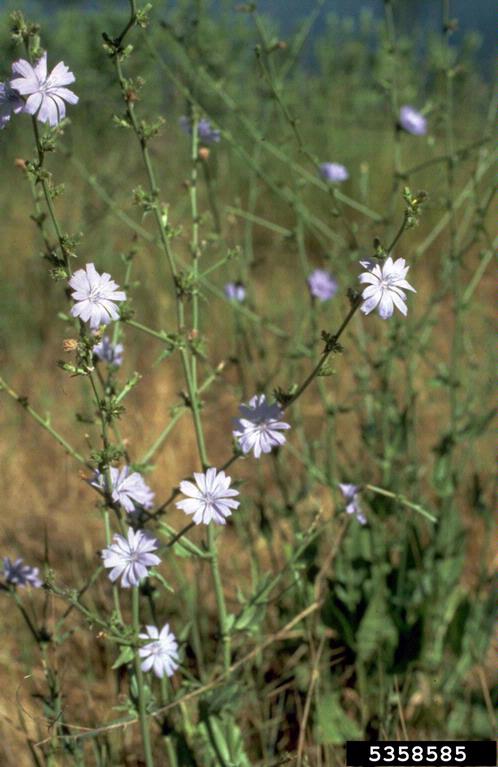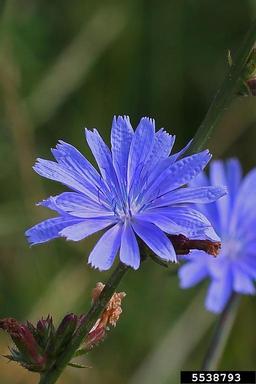Chicory (Cichorium intybus)
Introduction

Photo by L.L. Berry, Bugwood.org.
Chicory, also commonly called blue daisy, coffeeweed, and corn flower, is a forb in the Asteraceae family. It is native to Europe and has been reported in nearly all states and provinces of North America. Chicory is a species that receives mixed reviews from humans—some people consider it weedy while others celebrate its showy, blue flowers and edible and medicinal qualities. It can be weedy where disturbance is frequent, like roadsides, field edges, and waste areas, but it typically does not invade natural areas. Regardless of your perception of chicory, its flowers are arguably beautiful, and it has an interesting and storied history.
Identification and Biology
Chicory is a tap-rooted biennial or perennial. Leaves are lobed, toothed and 3 to 8 inches long. Most of the leaves are basal, and basal leaves are petiolate; stem leaves are clasping, but plants become nearly leafless near the top. Plants are usually 2 to 4 feet tall. Stems are hollow, stiff, irregularly branched, and commonly described as growing in a zig-zag pattern. Roots and stems exude a milky sap when broken. Sky-blue to purple flower heads are about 1 inch in diameter; ray florets have petals with squared and notched tips. Flowers are open in the morning and close as the day progresses. Only a few flowers open each day, and each head opens only for a single day. In Montana chicory is most evident July through early September.
Habitat and Spread

Photo by Rob Routledge, Sault College, Bugwood.org.
Roadsides, waste areas, fencerows, and pastures are common habitat for chicory. The strong taproot enables chicory to grow in hard-packed, rocky soil, but it can grow in a wide range of soils. Chicory reproduces through seed.
History and Uses
Chicory is most well known in the U.S. as a non-caffeinated coffee substitute, especially in New Orleans. Roots are roasted and ground to add color, body, and bitterness to coffee. Leaves are sometimes added to salads, and the plant has been explored as livestock forage. Chicory has been used to treat a variety of ailments from wounds to diabetes, cancer, and liver disorders. Although chicory has a rich history of use, its pharmaceutical qualities have yet to be fully explored.
Management
Should control be desired, multiple tactics are effective for managing chicory. For mechanical control, grubbing, digging, and hand pulling are very effective; mowing can reduce seed production, but plants usually regrow. Because chicory can be desirable forage, grazing can be used to control it, but it will regrow after grazing. There are no biological control agents for chicory. For chemical control, products containing 2,4-D, dicamba, aminopyralid, or clopyralid applied from rosette to bud stage are effective. When using herbicides, always read and follow product labels. Chicory is not a noxious weed in Montana, but it is listed in Colorado and New Mexico.
Further Information
For more information about this month's weed post, contact Extension Invasive Plant Specialist Jane Mangold. Past posts are available in the Monthly Weed Post Directory.
This weed post is also available as a printable PDF (568KB).
